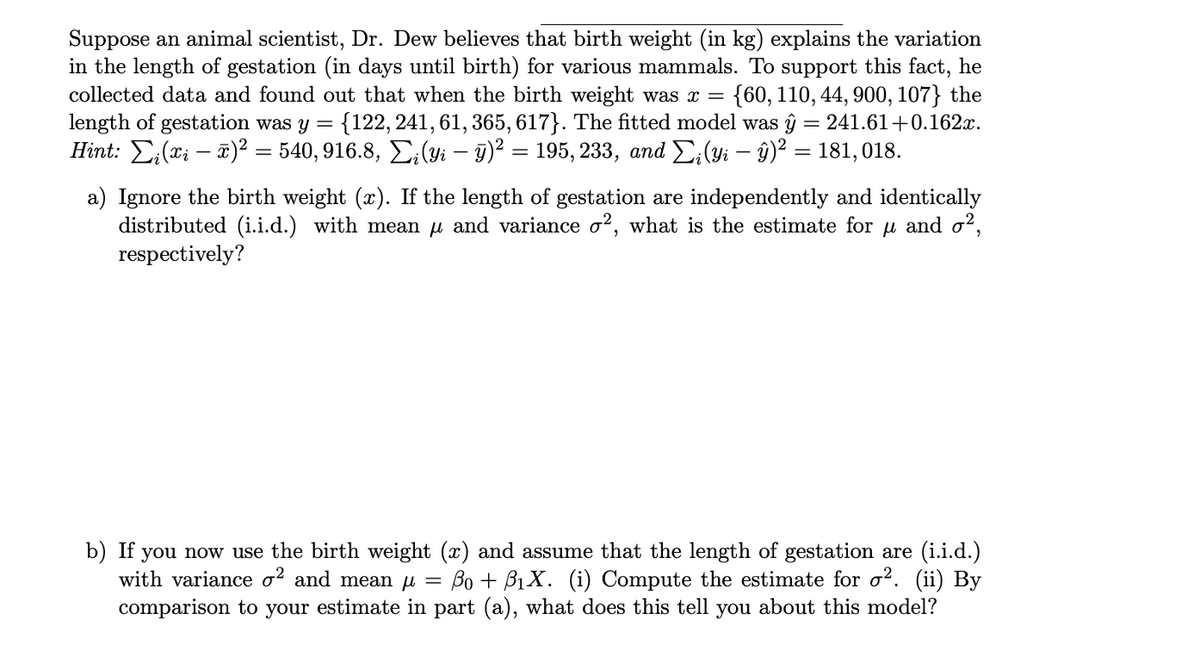Suppose an animal scientist, Dr. Dew believes that birth weight (in kg) explains the variation in the length of gestation (in days until birth) for various mammals. To support this fact, he collected data and found out that when the birth weight was x = length of gestation was y = Hint: E:(x; – a)² = 540, 916.8, E; (yi – 9)² = 195, 233, and E:(yi – ŷ)² = 181, 018. {60, 110, 44, 900, 107} the {122, 241, 61, 365, 617}. The fitted model was ŷ = 241.61+0.162x. a) Ignore the birth weight (x). If the length of gestation are independently and identically distributed (i.i.d.) with mean u and variance o?, what is the estimate for u and o?, respectively?
Suppose an animal scientist, Dr. Dew believes that birth weight (in kg) explains the variation in the length of gestation (in days until birth) for various mammals. To support this fact, he collected data and found out that when the birth weight was x = length of gestation was y = Hint: E:(x; – a)² = 540, 916.8, E; (yi – 9)² = 195, 233, and E:(yi – ŷ)² = 181, 018. {60, 110, 44, 900, 107} the {122, 241, 61, 365, 617}. The fitted model was ŷ = 241.61+0.162x. a) Ignore the birth weight (x). If the length of gestation are independently and identically distributed (i.i.d.) with mean u and variance o?, what is the estimate for u and o?, respectively?
Algebra & Trigonometry with Analytic Geometry
13th Edition
ISBN:9781133382119
Author:Swokowski
Publisher:Swokowski
Chapter7: Analytic Trigonometry
Section7.6: The Inverse Trigonometric Functions
Problem 93E
Related questions
Question

Transcribed Image Text:Suppose an animal scientist, Dr. Dew believes that birth weight (in kg) explains the variation
in the length of gestation (in days until birth) for various mammals. To support this fact, he
collected data and found out that when the birth weight was x =
length of gestation was y =
Hint: E;(xi – 2)² = 540, 916.8, E;(yi – 9)² = 195, 233, and E;(yi – ŷ)² = 181, 018.
{60, 110, 44, 900, 107} the
{122, 241, 61, 365, 617}. The fitted model was ĝ = 241.61+0.162x.
a) Ignore the birth weight (x). If the length of gestation are independently and identically
distributed (i.i.d.) with mean u and variance o?, what is the estimate for u and o?2,
respectively?
b) If you now use the birth weight (x) and assume that the length of gestation are (i.i.d.)
with variance o? and mean µ = Bo + B1X. i) Compute the estimate for o?. (ii) By
comparison to your estimate in part (a), what does this tell you about this model?
Expert Solution
This question has been solved!
Explore an expertly crafted, step-by-step solution for a thorough understanding of key concepts.
This is a popular solution!
Trending now
This is a popular solution!
Step by step
Solved in 3 steps

Knowledge Booster
Learn more about
Need a deep-dive on the concept behind this application? Look no further. Learn more about this topic, statistics and related others by exploring similar questions and additional content below.Recommended textbooks for you

Algebra & Trigonometry with Analytic Geometry
Algebra
ISBN:
9781133382119
Author:
Swokowski
Publisher:
Cengage

Functions and Change: A Modeling Approach to Coll…
Algebra
ISBN:
9781337111348
Author:
Bruce Crauder, Benny Evans, Alan Noell
Publisher:
Cengage Learning

Algebra & Trigonometry with Analytic Geometry
Algebra
ISBN:
9781133382119
Author:
Swokowski
Publisher:
Cengage

Functions and Change: A Modeling Approach to Coll…
Algebra
ISBN:
9781337111348
Author:
Bruce Crauder, Benny Evans, Alan Noell
Publisher:
Cengage Learning